2014新版六年级英语上册unit2 第一课时
人教PEP版六年级英语上册《Unit 2 第1课时》教学设计教案小学公开课

第一课时课时内容A Let’s learn;Write and say课时分析本课时是人教版六年级上册第二单元第一课时。
围绕“交通方式”这一话题展开,主要学习关于交通方式的词组by plane,by train,by taxi,by ship,on foot,by bus,by subway以及运用句型How do we get there?...谈论交通方式的选择。
保持学生学习英语的兴趣,树立学好英语的信心。
第一课时是本单元的首课时,是整个单元的基础。
本课时的重点是四会词组的掌握以及能够运用四会词组讨论交通方式。
本课时包括Let’s learn和Write and say两个版块。
Let’s learn通过Mrs Smith和学生们谈论下周三如何去自然公园的场景呈现了四会词组的词形和意义。
此情境是与学生的实际生活相关的,话题很能引起学生的兴趣。
Write and say版块是一个综合性的语言运用活动。
学生可以通过这个活动结合自己的实际巩固运用A部分所学的词汇和句型。
本课时虽然是新授课,但是单词foot,bus,taxi,bike,plane在三年级的教材中已经学过,为本课的学习打下了很好的基础。
在设计本课教学过程时,采用引导学习和自主学习相结合的方式,运用情景教学法、愉快教学法、合作学习法等教学方法,调动全体学生学习的积极参与,培养学生学习的兴趣。
课时目标(1)能够听、说、读、写词组:by plane,by train,by taxi,by ship,on foot,by bus,by subway (2)能够听、说、读、写句型How can you get there?By bus.(3)能够结合句型How do we get there?By bus/...谈论交通方式的选择。
(5)保持学生学习英语的兴趣,树立学好英语的信心。
课时重难点1.重点(1)能够听、说、读、写词组:by plane,by train,by taxi,by ship,on foot,by bus,by subway (2)能够听、说、读、写句型How can you get there?By bus.(3)能够结合句型How do we get there?By bus/...谈论交通方式的选择。
pep小学六年级英语上册 Unit 2第一课时教案

pep小学六年级英语上册Unit 2第一课时教案pepц?Unit 2銆€Unit 2涓€銆乼eaching aims: 1.hospital锛宑inema锛宲ost office锛宐ookstore 2.煭璇璼cience museum銆?3.here is the library? It's near the post office銆?4.В骞朵細鍚熷敱Let's chant鐨勬瓕璋c€?5.air work锛?浜屻€乼eaching importance and difficulties 1et's learn?2銆佸噯museum鐨勫彂闊炽€?涓夈€乸reparations: 12鍦ㄩ粦鏉夸笂涔﹀啓鍗曡瘝銆?鍥涖€乸rocedures: 1. Warm-up (1)Game (2)Greeting: Today, I go to school on foot.What about you? 2锛嶱resentation Let's learn (1) listen and say T: I want to post the letter. Where can I go? (post office) Oh, I feel bad, I need to see a doctor. Where can I go? (hospital) I鈥檓ok now,I want to see a film, Where can I go? (cinema) I need to buy some books, where can I go? (bookstore) Q: Where is the post office? (It鈥檚near the hospital.) E: We also can say 鈥渋t鈥檚next to the hospital.鈥?Can you guess what meaning of 鈥渘ext to鈥? (It鈥檚the same as near.) (2)let鈥檚chant P14 (3)There are other two building. Look at this one,this is a science museum.the other one is library. In the map,there are 2 blanks A and B. Now, please guess where are they? Sence: I want to go to the library, but I don鈥檛know how to get to the library? Can you help me? Q: Excuse me,How can I get to thelibrary? A: Q: Where is the library? A: Listen to the tape,read after it. (4) Make dialogues (5) Next week, we will have a long holiday. I want to go to Beijing.I prepare a map. But it鈥檚too small, who can help me write it on Bb? (6) Do the same with partners. 浜斻€丠omework Copy the 4-skilled words, each 5 times. ote: 璇惧悗鍙嶆€?。
新版牛津译林苏教版六年级英语上册Unit 2 What a day第一课时优质课课件
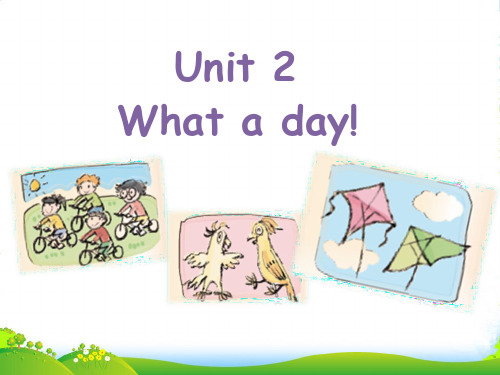
Unit 2 What a day! How to write a diary?
Date 日期
[eɪ]
Weather 天气
[e] [ǝ]
Special(特别的)things
Unit 2 What a day! Yang Ling’s diary:
Date: Sunday, 20th September
Unit 2 What a day!
Yang Ling’s diary:
Special things:
A
B
C
Read Yang Ling’s diary and D try to ordEer(排序).F
Right order: ___C_-__A_-_B__-_E_-_F__-_D__
Unit 2 What a day! Special things:
Unit 2 What a day!
Tips: 1. 日期中要用到序数词代表“几日” 2. 序数词表达方式:
一般在基数词后加th,表示“第几” 特殊情况:
one—first, two – second, three – third 以ve结尾,变ve为f再加th。例如:five—fifth, twelve— twelfth 以e结尾,去e加th。例如:nine—ninth 以t结尾,直接加h。例如:eight—eighth 以ty结尾,去y加ie再加th。例如:twenty—twentieth 缩略写法:数字+序数词的最后两个字母。例如: 20th, 1st, 2nd, 3rd
become 变成,变为 [ʌ]
过去式: became [eɪ]
Unit 2 What a day!
Yang Ling’s diary: Weather: 1. It was…in the morning. 2. Then, the weather became … 3. In the afternoon, there were black clouds in the sky. It …
六年级英语上册unit2第一课时课件

How do you get to Paris?
Never on foot , never by bike Always by car, bus, or plane.
ship
by train
Is this a train?
subway by subwaytaxi
by train
by plane
by ship
How do you go to school?
Sometimes by bike,
Sometimes by car,
Unit 2 Ways to go to school
A let’s talk
I come to school by bike. bike
What’s this?
by bike
How do you come to school?
(你怎么来学校?)
I come to school on foot.
Usually> often> sometimes
通常 经常 有时
How do you come to school?
I often come on foot.
on foot=walk(步行)
A let’s talk
New words
课文新单词。
Mrs[ʹmısız] Smith 史密斯夫人 early [ʹə:li ]早到的 Children 儿童
on foot
by bus
How do you come to school? I come to school ______.
by car
by taxi
人教PEP版六年级英语上册 Unit 2 Part B 第一课时 教学课件完整版

1
2
3
4
5
67
8
Role-play
四人一组,其中一人扮演盲人,其他一人或两人做带路 者,一人或两人演示红绿灯。
A: Excuse me. How can I get to ...?
B: Go straight/Turn left/... Let me help you. It’s ... light. Slow down and wait/Stop and wait/Go ...
人教PEP版英语六年级上册
Unit 2
Ways to go to school Part B
Let’s learn & Roleplay
Warm up
Ask and answer. T: How do you come to school? Why? S: I come ... It’s far/near.
Mike: Look! The
is over
there! Let’s go!
Mrs Smith: Please wait! It’s
now.
We must
.
Practice
What’s next?
游戏规则: 教师出示一组单词卡片,学生快速认读。认读两遍后,教师在某
处停住,提问What’s next?学生根据记忆说出单词。
3. 你们可以在绿灯的时候走。
You can _____g_o__ ____a_t___ a green பைடு நூலகம்ight.
4. 在黄灯的时候要减速慢行。
__S_l_o_w_ __d_o_w_n_ ___a_t__a __y_e_ll_o_w_ light.
Summary
人教新起点小学英语六年级上册Unit2教案——第一课时

出示第二张地图和图片:This is Canada. Toronto is in thesoutheast of the Canada. It’s famous for the CN Tower.老师用多媒体课件展示加拿大电视塔,领读单词。
3.使学生掌握Let’s spell中字母组合ear的两种发音规律。
教学重点
能够仿照本课所学句型对将要寒假旅游的世界名胜进行口语交流。教学难点
一些世界出名旅游地London, Toronto, Sydney, WashingtonD.C. the British Museum, the CN Tower, kangaroo, the OperaHouse, the White House等的读音。
Step3 Practice
1.同桌两人一组使用世界各地风景图片,相互读图片表达的词语。2.小游戏:四人为一组,把所有图片放在一起,一名同学随意抽取出来一张,其他同学迅速读词语,看谁读得又快又好。
3.找朋友小游戏:把图片分为三类:国家名,城市名,名胜风景,分别把这三类图片分发给同学们,然后同学们开始找朋友了,国家,城市,风景对上了,就算是一组朋友了。看哪一组找得又快又对。教师用“学乐师生”APP录像,把活动场面再次分享给全体同学。
Step4 Presentation
1.教师播放课件,展示两个同学的对话。教师讲解:
Where do you want to go this winter vacation?今年寒假你想去哪?
译林版英语六年级上册_Unit2_第1课时教学设计
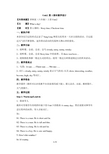
Unit2 第1课时教学设计【内容来源】译林版(六年级)上册Unit2【主题】What a day!【课时】第1课时:Story time; Checkout time一、板块介绍本部分以日记的形式记录了Yang Ling和朋友们周末一天在公园的活动。
日记通过天气的不断变换,逐步推动活动的发展和人物心理的变化。
二、教学目标1、能听懂、会说、会读、会写cloudy, rainy, sunny, windy;2、能听懂、会说、会读Story time中的故事,及there was/were…3、能够熟练掌握一般过去式的用法,能用一般过去时描述刚过去的周末活动。
三、教学重难点1、句型:It was …. /There was …. /We saw ….2、词汇:cloudy, rainy, sunny, windy表示天气的词;以及show, interesting, weather, become, high, sky等词汇。
四、教学准备教学课件(教师可以在优教平台直接调用或下载)、课文录音、动画、教材图片、天气类图片。
五、教学过程Step 1: Warm-up/Lead-in1.歌曲导人教师可带领学生再唱四年级下册Unit 5的歌曲A sunny day,然后就歌词和学生进行简单的问答,导入目标词汇。
如:S1: There is a man. He is short and fat.S2: There is a man. He is tall and thin.S3: There is a king. He is old and fat.S4: There is a boy. He is cute and happy.T: How’s the weath er?Ss: It’s sunny.T: What can you see on a sunny day?Ss: We can see the sun and a blue sky.T: what can we do on a sunny day.S1: We can fly kites in the park.S2: We can go boating.S3: We can have a picnic.S4: We can go for an outing.2. 问答导入教师利用课件呈现孩子们在公园玩耍的场景,并与学生进行简单问答,复习已学过的知识。
(湘少版)六年级英语上册 《Unit2第1课时》教案设计2
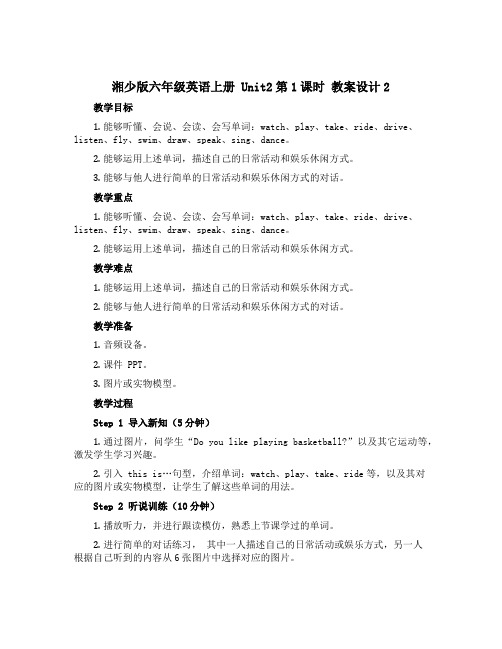
湘少版六年级英语上册 Unit2第1课时教案设计2教学目标1.能够听懂、会说、会读、会写单词:watch、play、take、ride、drive、listen、fly、swim、draw、speak、sing、dance。
2.能够运用上述单词,描述自己的日常活动和娱乐休闲方式。
3.能够与他人进行简单的日常活动和娱乐休闲方式的对话。
教学重点1.能够听懂、会说、会读、会写单词:watch、play、take、ride、drive、listen、fly、swim、draw、speak、sing、dance。
2.能够运用上述单词,描述自己的日常活动和娱乐休闲方式。
教学难点1.能够运用上述单词,描述自己的日常活动和娱乐休闲方式。
2.能够与他人进行简单的日常活动和娱乐休闲方式的对话。
教学准备1.音频设备。
2.课件 PPT。
3.图片或实物模型。
教学过程Step 1 导入新知(5分钟)1.通过图片,问学生“Do you like playing basketball?”以及其它运动等,激发学生学习兴趣。
2.引入 this is…句型,介绍单词:watch、play、take、ride等,以及其对应的图片或实物模型,让学生了解这些单词的用法。
Step 2 听说训练(10分钟)1.播放听力,并进行跟读模仿,熟悉上节课学过的单词。
2.进行简单的对话练习,其中一人描述自己的日常活动或娱乐方式,另一人根据自己听到的内容从6张图片中选择对应的图片。
示例对话: A: What do you do on Saturday? B: I often watch TV and draw pictures.Step 3 语音朗读(10分钟)1.向学生讲解音标,及其在单词发音中的应用(如/æ/ 在 play 中)。
2.对学生进行单词读音的朗读训练。
Step 4 练习(20分钟)1.分组进行问答,每组4人,轮流进行自我介绍和问答练习,内容包括学生个人日常活动和娱乐休闲方式。
人教PEP版六年级英语上册《Unit 2 Part B 第一课时》同步练习题及参考答案

A. redB. busC. stopD. waitE. planeF. yellowG. train I. green J. slow down Unit 2 Part B 第一课时(Let's learn-Role-play)一、听录音,圈出你所听到的单词。
1. A. red B. yellowC. green2. A. go B. stop C. wait3. A. must B. often C. sometimes4. A. early B. lightC. usually二、听录音,标号。
() Slow down and stop at a yellow light. () Stop and wait at a red light. () Go at a green light.() The park is over there.三、认识 traffic lights ,连一连。
1. G o.A.B.2. Stop and wait.C.3. Slow down and stop.四、按要求分类。
1.交通灯颜色2.交通灯含义3.交通工具五、看图,选词填空。
1.(Go/Wait)at a green light.2.Look at the (traffic rules/traffic lights).3.(Stop and wait/Wait)at a red light.4.(Slow down and stop/Go)at ayellow light.参考答案一、1.A 2.C 3.A 4.B二、3124三、1.C2.A3.B四、1.AFI 2.CDHJ 3.BEG五、1.Go 2.traffic lights 3.Stop and wait 4.Slow down and stop听力材料一、听录音,圈出你所听到的单词。
1.red2.wait3.must4.light二、听录音,标号。
人教PEP版英语六年级上册课时练习-Unit2Waystogotoschool第一课时含答案

Unit 2 ways to go to schoolLet’s try & Let’s talk(第一课时)基础巩固一、为下列图片选择正确的短语。
1. 2. 3. 4.( ) ()()()A.by bikeB.on footC.by busD.by car二、单项选择。
( )1. do you go to school?A.HowB.WhatC.Where( )2.I usually come to school .A.by a bikeB.by bikeC.ride a bike( )3.Walking is good .A.exerciseB.exercisesC.a exercise( )4.I go to work by car.A.some timesB.sometimeC.sometimes三、连词成句。
1.to,come,school,how,do ,you2.by,come,bus,sometimes,I3.is,good,exercise,that4.early,are,you能力提升四、根据下列表格,选择合适的句子补全对话。
By bike By bus By car On foot Mike usually√√Amy often√√√√Sarah sometimes√√√√John√√√√1.Mr Smith:How do you come to school,Mike?Mike:2.Mr Smith:How do you come to school,Amy?Amy:3.Mr Smith:How do you come to school,Sarah?Sarah:4. Mr Smith:How do you come to school,John?John:五、阅读短文,判断下列句子(T)否(F)正确。
Mike,Amy,Sarah and WuYifan are classmates.They usually go to school at 7:30.Mike usually goes to school by bike,but sometimes he goes to school by bus.Amy often goes to school by bus.Sarah sometimes goes to school by bus.But she often goes to school on foot.WuYifan goes to school by bike everyday.( )1.Mike sometimes goes to school by bus.( )2.Amy usually goes to school by bus.( )3.Sarah sometimes goes to school on foot.( )4They usually go to school at 7:00.( )5. WuYifan usually goes to school by bike.参考答案:一、B C D A二、A B A C三、1.How do you come to school?2.Sometimes I come by bus.3.That is good exercise.四、D B A C五、T F F F F。
Unit2 What a day! (Story time)(教案)英语六年级上册

5点击显示按钮,呈现we could not eat our lunch并带读进而为下面情感的渗透估好铺垫。
6Read and fill环节中,调出倒计时,让学生在规定的时间里完成书写并发送的任务,培养学生时间观念及互助意识。
7让学生上台用硬笔书写单词,写错时可及时更改,体现了白板的易操作性。
3插入视频
4聚光灯
5插入声音
【功能分析】
①在规定的时间里猜答案,既可集中注意力又可大大提高学生学习的热情与参与度。
②上课伊始,利用纹理笔刮擦出本课的三类单词weather,引发学生好奇心,集中注意力。
③播放一首天气类的卡通歌曲,让学生提前感知天气类单词,营造唱游娱乐语境,拉近师生间距离,为下面文本的学习做铺垫。
2有利于学生模仿纯正语音
Step3
Post-reading
读后活动
32’47”-
39 ’38”
巩固所学内容,学生能运用所学知识点进行有效的语言输出。
与学生分享一篇老师的日记,并完成两个任务:
1.Talk about Miss Wang’s day.
2.Help Miss Wang with the diary.
cloudy/windy.
We brought/
saw/flew…的表达。
1.呈现一幅老师收集的杨玲的图片,询问学生她在干什么?引出She wrote a diary.揭题
What a day
2.初步感知文本,了解大意,完成两个阅读任务:
(1)Listen and choose.
(2)Read,under-line and order
Unit2 What a day!
六年级英语上册Unit2《Mysummerholiday》(第1课时)教案

My summer holiday课题My summer holiday单元2学科英语年级六年级上册1.能够掌握含行为动词的一般过去时。
学习 2. 掌握的单词及其短语:famous,during , spend,everyone , countryside ,pick ,summer 目标holiday.3.写一篇关于你的暑假的日记。
重点1)描述自己身边熟悉的人的以前的一些外貌特征。
2)理解含行为动词的一般过去时的用法。
3)两朋友之间用一般过去时互相描述对方以前的特点。
难点1)含行为动词的一般过去时的使用。
2)动词原形变为动词过去式的规则教学过程教学环节教师活动学生活动设计意图导入新课Warming-up and revision 仔细观看视视频具有很强1.Greet the Ss as usual. Check the homework. 频,直观感受的视觉冲击力,2.Have a game .播放有关夏令营的视频暑假的到来能吸引学生的注意力,使学生很快的融入课堂之中。
讲授新课Ⅰ.Free talk Ⅰ.学生小组Ⅰ.活跃课堂气1.What did you do on your summer holiday ?讨论在暑假中氛,使学生轻松2.What did you think of it ?的活动的学习英语。
Ⅱ. Presentation Ⅱ. ( 1)学生Ⅱ.使学生快速Step 1. 课文展示阅读课文。
的了解课文大(1)老师展示课本内容(2)学生仔意。
Step 2. 老师播放课文录音细听课文录(T shows the text ,and ask some questions about 音,并回答老the text ,then play the recording for the Ss 师所提的问to listen to the text. )题。
2. ( 1)图片含有Step 3 . 单词讲解 2. 教师先领丰富的色彩,能①T: This is summer holiday. This is famous . 读,然后男生够吸引学生的注This class, we'll learn something about my 读,女生读,意力,使学生积summer holiday.链式读,给出极的参与课堂的(Show the pictures of the new words on the汉语说英语,学习中来。
六年级英语上册课件Unit2Waystogotoschool第一课时人教PEP共14张PPT

3. U___________(通常), I come by bike, s__________(有时) I walk.
She is sometimes very sad. 她有时候很伤心。 b. 在第一个助动词或情态动词之后。如:
I can’t always go to the zoo.我不能总是去动物园。 c. 在实义动词之前。如:
We often go there. 我们常去那儿。 ◆sometimes也可放在句首、句中或句末,often也可放在句 末(一般不放在句首)。
--I usually/sometimes/ often come...
Homework
回家调查父母及其他亲戚的上 班方式,准备下一节做汇报。
TThhanaknykouy!ou!
Complete the form with your group, and retell. Such as, Amy usually comes to school on foot. She sometimes come by bus. Mike ofen comes by bike. Mrs. Smith.....
Mike
Amy
John
频率副词
always(总是)sometimes(有时) usually (通常;经常) often (常常,时常)never(从来没有) 等词在英文中被称为“频度副词”, 是用来表示动作频率的,但程度上 有别。
频率副词的用法
频度副词在句中习惯上位于be动词、助动词等之后,行为动 词之前。 a. 在be动词之后。如:
北师大版小学英语六年级上册
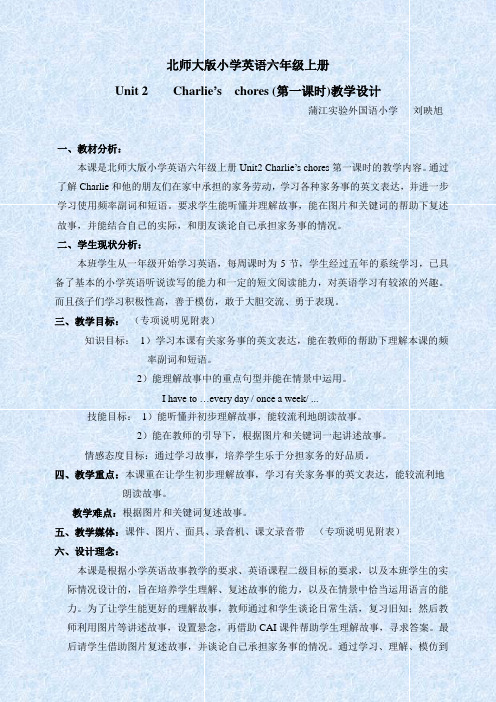
北师大版小学英语六年级上册Unit 2 Charlie’s chores (第一课时)教学设计蒲江实验外国语小学刘映旭一、教材分析:本课是北师大版小学英语六年级上册Unit2 Charlie’s chores第一课时的教学内容。
通过了解Charlie和他的朋友们在家中承担的家务劳动,学习各种家务事的英文表达,并进一步学习使用频率副词和短语。
要求学生能听懂并理解故事,能在图片和关键词的帮助下复述故事,并能结合自己的实际,和朋友谈论自己承担家务事的情况。
二、学生现状分析:本班学生从一年级开始学习英语,每周课时为5节,学生经过五年的系统学习,已具备了基本的小学英语听说读写的能力和一定的短文阅读能力,对英语学习有较浓的兴趣。
而且孩子们学习积极性高,善于模仿,敢于大胆交流、勇于表现。
三、教学目标:(专项说明见附表)知识目标:1)学习本课有关家务事的英文表达,能在教师的帮助下理解本课的频率副词和短语。
2)能理解故事中的重点句型并能在情景中运用。
I have to …every day / once a week/ ...技能目标:1)能听懂并初步理解故事,能较流利地朗读故事。
2)能在教师的引导下,根据图片和关键词一起讲述故事。
情感态度目标:通过学习故事,培养学生乐于分担家务的好品质。
四、教学重点:本课重在让学生初步理解故事,学习有关家务事的英文表达,能较流利地朗读故事。
教学难点:根据图片和关键词复述故事。
五、教学媒体:课件、图片、面具、录音机、课文录音带(专项说明见附表)六、设计理念:本课是根据小学英语故事教学的要求、英语课程二级目标的要求,以及本班学生的实际情况设计的,旨在培养学生理解、复述故事的能力,以及在情景中恰当运用语言的能力。
为了让学生能更好的理解故事,教师通过和学生谈论日常生活,复习旧知;然后教师利用图片等讲述故事,设置悬念,再借助CAI课件帮助学生理解故事,寻求答案。
最后请学生借助图片复述故事,并谈论自己承担家务事的情况。
六年级上册英语教学设计《Unit2Waystogotoschool第一课时》人教(PEP)

六年级上册英语教学设计《Unit 2Ways to go to school第一课时》人教(PEP)一. 教材分析《Unit 2 Ways to go to school》是PEP教材六年级上册的第二单元,本单元主要让学生学会描述自己去学校的方式,以及询问别人去学校的方式。
本课时为第一课时,主要学习一般现在时态,以及与上学方式相关的词汇和句型。
教材内容丰富,贴近学生生活,有利于激发学生的学习兴趣,培养他们的交际能力。
二. 学情分析六年级的学生已经具备了一定的英语基础,能够听、说、读、写一些简单的英语句子。
但部分学生在语言表达上还存在一定的困难,尤其是对于一般现在时态的运用。
因此,在教学过程中,需要关注学生的个体差异,合理安排教学内容,以确保每个学生都能在课堂上得到充分的练习和提高。
三. 教学目标1.知识目标:–学会一般现在时态的句型结构。
–掌握与上学方式相关的词汇,如bus, subway, walk, bike等。
–能够用英语描述自己去学校的方式。
2.能力目标:–能够听、说、读、写一般现在时态的句子。
–能够在实际情景中运用所学词汇和句型进行交际。
3.情感目标:–培养学生的团队协作精神,增强他们的自信心。
四. 教学重难点•一般现在时态的句型结构。
•与上学方式相关的词汇。
•一般现在时态的运用。
•如何在实际情景中运用所学词汇和句型进行交际。
五. 教学方法1.任务型教学法:通过设计各种任务,让学生在实践中掌握知识,提高交际能力。
2.情境教学法:创设真实的情景,让学生在特定的语境中学习英语。
3.小组合作学习:培养学生团队协作精神,提高课堂参与度。
六. 教学准备1.教学PPT:包含本课时的教学内容、图片、动画等。
2.教学卡片:用于操练和巩固所学词汇和句型。
3.录音机、磁带或音频文件:用于播放听力材料。
4.情景剧剧本:用于课堂表演。
七. 教学过程1.导入(5分钟)–利用PPT展示各种交通工具的图片,引导学生谈论自己去学校的方式。
(人教pep)2014秋 六年级上册PPT课件Unit2 Ways to go to schoo第一课时

on foot = walk to... by bike = ride the bike to... 句尾 主语后 by car = take the car to... by bus = take the bus to... 句尾 主语后
How does he get to school?
He goes to school by bike.
=
He rides a bike to school.
How does she go to work?
by train She goes to work ___________.
She takes the train to work.
How does he go to work?
He goes to work by subway.
Read the text and answer the questions.
率 副 词
绿色圃中小学教育网
How do you get to…from…? I get there by….
乌鲁木齐 北京
汉中
合肥 上海 嘉善 杭州
日本
云南
绿色圃中小学教育网
How does Mike come to school? How does Amy come to school? How does Mrs. Smith come to school? always 总是 频
usually 通常 often 经常,时常 sometimes 有时 never 从不
绿色圃中小学教育网
绿色圃中小学教育网
How do you come to school?
I come to school on foot.
新版2014年小学英语六年级上册Unit2Read-and-write
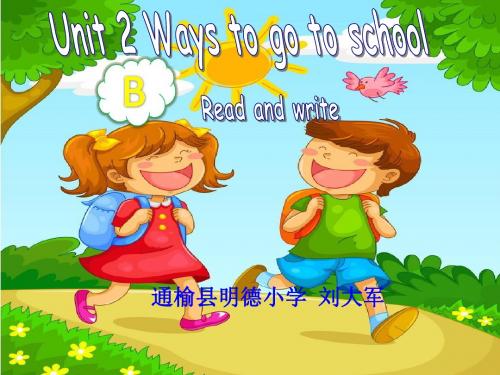
a lot of people (不可数名词)
While-readingFra bibliotekWhile-reading
Munich, Germany.
/ 'mju:nik/慕尼黑 /'dʒə:məni / 德 国
Munich
/ 'mju:nik/慕尼黑
Germany/'dʒə:məni /
英国海岛学生乘坐世界最短客运航班上学回家 因渡轮翻修停开,生活在英国苏格兰(Scotland) 一座偏远海岛上的孩子上学的方式非常特别——他 们每周乘坐飞机往返于学校和家里!而且,他们乘 坐的可能还是世界上航程最短的航班。平均飞行时 间96秒,最短飞行时间仅47秒。
While-reading
Fasten the safety belt. Turn off the mobile phone.
德 国
Some children go to school on foot in Munich,Germany.
慕尼黑啤酒节
• 每年十月的慕尼黑啤酒节是世界上最盛大 的民间节日,届时会有来自世界各地的五 百多万宾客来此欢度这一盛大的节日。慕 尼黑的啤酒节源于1810年为庆贺巴伐利亚 的储君德亲王与萨克森-希尔登豪森的黛 丽丝公主共结百年之好而举行的一系列庆 祝活动。
Post-reading 根据图示,全班尝试一起描述。
Children have different ways to go to school. Some children go to school _______ in ____. ... What about you?
Kunming
Guizhou
- 1、下载文档前请自行甄别文档内容的完整性,平台不提供额外的编辑、内容补充、找答案等附加服务。
- 2、"仅部分预览"的文档,不可在线预览部分如存在完整性等问题,可反馈申请退款(可完整预览的文档不适用该条件!)。
- 3、如文档侵犯您的权益,请联系客服反馈,我们会尽快为您处理(人工客服工作时间:9:00-18:30)。
She usually comes on foot.
Let’s try
Listen and tick or cross.
(
×
)1.They are talking about a sports meeting.
√
(
)2.They will go by bus.
Time for reading 读对话,判断正(√)误( × )
Mike: Sarah,let’s go to the park this afternoon. Sarah:Great!But how do we go to the park?
Mike:It’s e to my home by bike.We can goto the bus stop on foot.Then we go to the park by bus.
goes to work ______ by bus He ______ ________.
feet I have two _________(foot). 那是个不错的运动。 exercise That’s good _________. 我哥哥通常步行去上班。 to work. My brother usually _____ walk _____ on ____ foot My brother usually go to work ___
Sarah:OK.But Where is your home? Mike:My home is near the poost offfice. Sarah:Which floor? Mike:The fifth floor.Room 5A. Sarah:OK!Ths afternoon.See you at 2 o’clock. Mike: See you then!
How does he go home? He goes home _________. on foot He walks home.
How do they go to the park? by bus I go there_________.
I take the bus there.
Write and say From How?
office.
根据句意完成句子。
1.--你每天怎样来学校?---我通常步行来。 ______ How do you come to school every day? on foot I usually come ______ ________.
2.格林先生有三个孩子。 children Mr Green _____ has three ________. 3.--你父亲通常怎样上班?--他乘公共汽车去上班。 How does your father usually go to work? ____ _____
I can get to the bookstore on foot. How can you get to the bookstore? ____ ____ Jack often comes to school by bus. does Jack often come to school? ____ ____ How We get to the cinema by taxi. gets to the cinema. Mike _____
bike car bus taxi subwa plane y ship
How do you go to school?
Do a surs
I usually\often\sometimes go...
How do you go to school? by bike I go to school _________. I ride my bike to school. How do you go to Canada? I go to Canada _________. by plane I take the plane to Canada. I fly to Canada.
on foot
by bus
by taxi
by plane
by
train
by
ship
by
subway
by bike
Let’s learn
A:How do you come to school? B:I usually\ often\sometimes come on foot.
I come by
China
your school your home
to
USA
your home Kurle
A: How do you get to the USA from China?
B: By plane.
Let’s talk 1.How does Amy come to school? Usually she comes to school on foot. Sometimes she comes by bus. 2.How does Mike come to school? He often comes by bike. 3.How does Mrs Smith come to school? She usually walks.
读对话,判断正(√)误( × )
( √ )1.Sarah goes to Mike’s home by bike.
× ( )2.They can go to the bus stop by × bus. √ ( )3.They can go to the park on foot. × ( )4.Mike’s home is near the post
